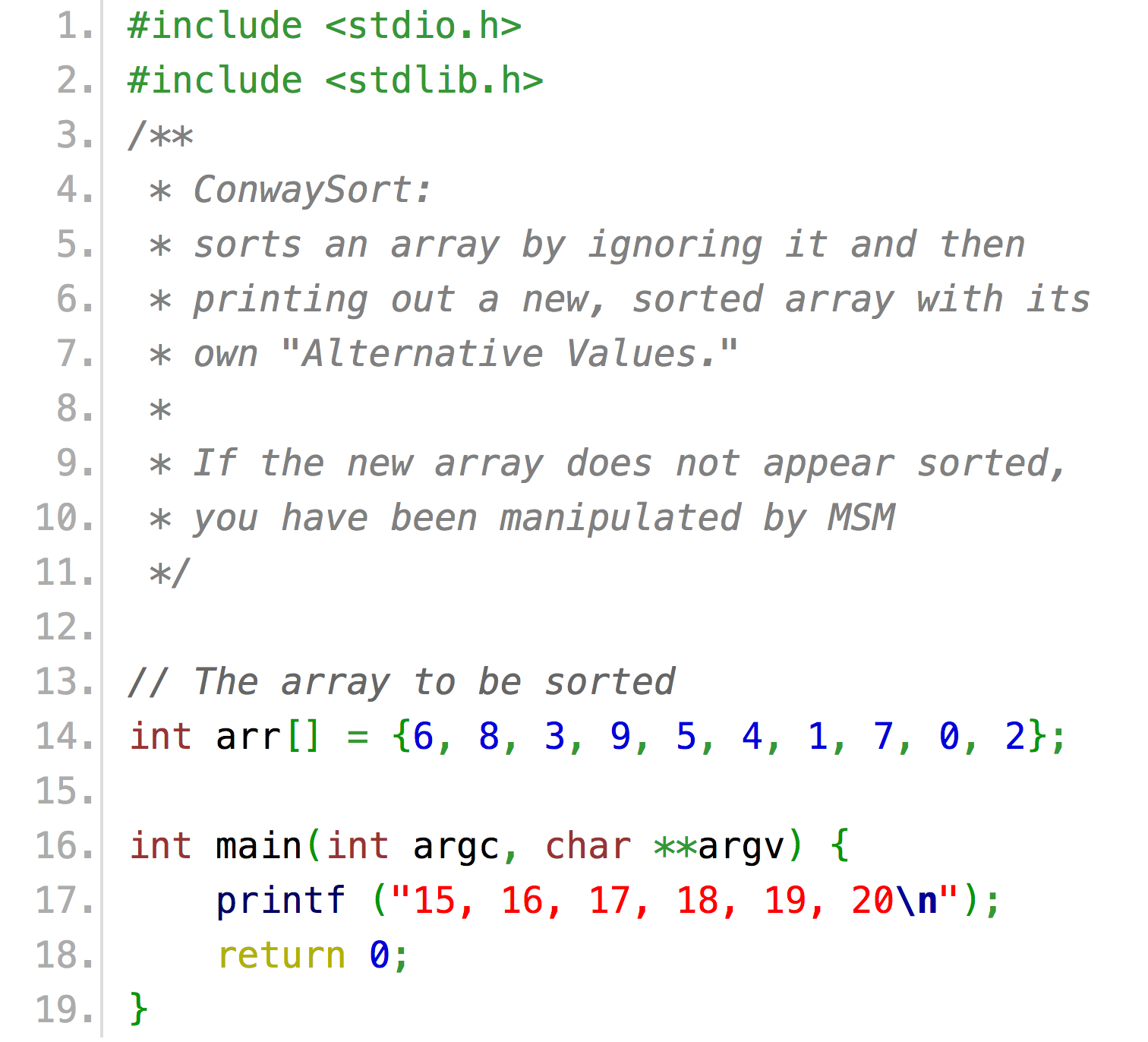
Hint: only some of these are jokes…
https://en.wikipedia.org/wiki/Bogosort
The alpha particles from the sun flip a few bits in the memory once a
while,
so this algorithm basically hopes that this flipping can cause the
elements to be sorted:
1. Check if the array is sorted.
2. If yes, praise your luck and print the magically sorted
elements.
3. if no, wait for some random amount of time(Secretly hope that the
alpha particles work their magic)
4. Go back to step 1.
https://en.wikipedia.org/wiki/Gnome_sort
It’s works exactly like bubble sort, but for each comparison instead of using ‘<’ and ‘>’ operators it posts a question on Quora asking which value is greater.
For example, Quora question: Which is greater - 5 or 7?
https://en.wikipedia.org/wiki/Stooge_sort

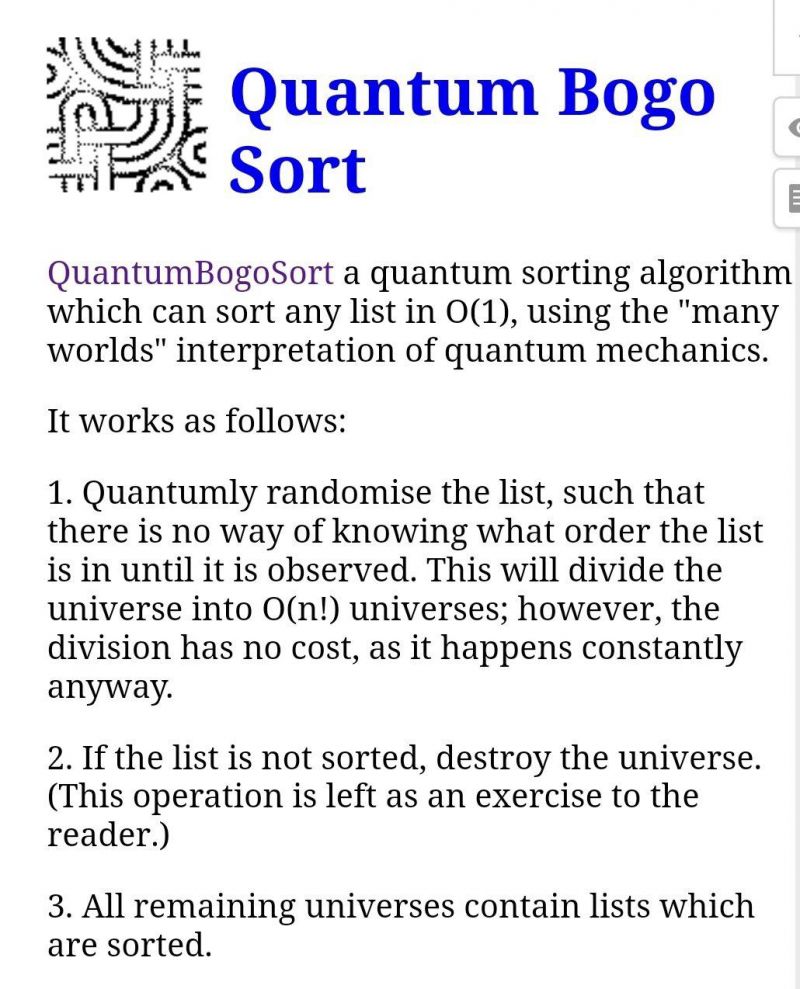
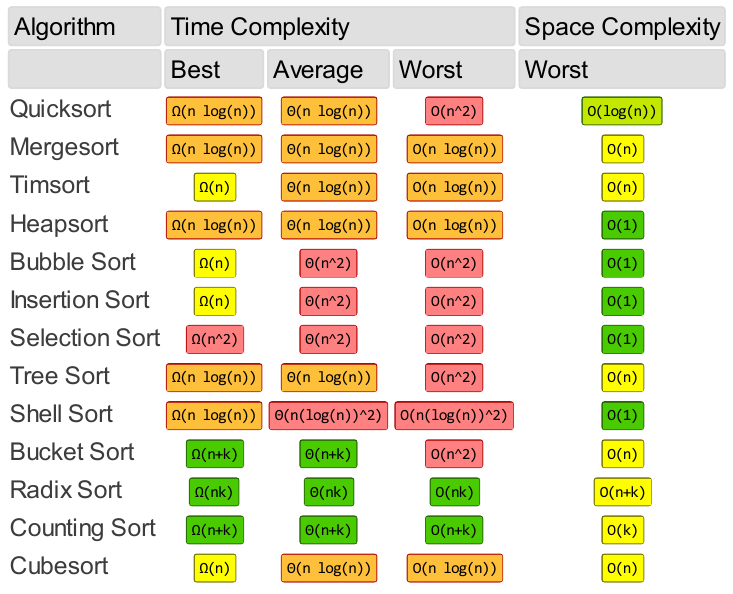
* Full comparison-based sorts can only do as fast as O(n(log(n)) in the
average case.
* Bucket, Radix, and Counting sort are better for
limited types of data
Ask: Given unlimited space, there is a perfect sorting algorithm, that can be coded in 2 lines. What is it?
Elements are distributed into bins

Then, elements are sorted within each bin


Using a list of lists

// Bucket sort
#include <iostream>
#include <algorithm>
#include <vector>
// Function to sort arr[] of size n using bucket sort
void bucketSort(float arr[], int n)
{
// 1) Create n empty buckets
std::vector<float> b[n];
// 2) Put array elements in different buckets
for(int i = 0; i < n; i++)
{
// Index in bucket - note, arr[i] is float,
// so times ~10 will truncate the less significant end of the number.
// Bucket indexing can vary widely.
int bi = n * arr[i];
b[bi].push_back(arr[i]);
}
// 3) Sort individual buckets
for(int i = 0; i < n; i++)
std::sort(b[i].begin(), b[i].end());
// 4) Concatenate all buckets into arr[]
int index = 0;
for(int i = 0; i < n; i++)
for (int j = 0; j < b[i].size(); j++)
arr[index++] = b[i][j];
}
int main()
{
float arr[] = {0.897, 0.565, 0.656, 0.1234, 0.665, 0.3434};
int n = sizeof(arr) / sizeof(arr[0]);
bucketSort(arr, n);
std::cout << "Sorted array is\n";
for(int i = 0; i < n; i++)
std::cout << arr[i] << " ";
return 0;
}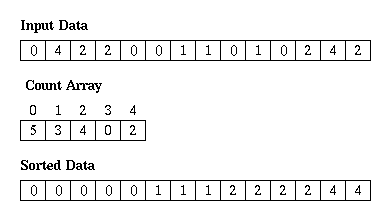
* Counting sort is an algorithm for sorting a collection of objects
according to keys that are small integers; that is, it is an integer
sorting algorithm.
* The algorithm loops over the items, computing a histogram of the
number of times each key occurs within the input collection.
* It then performs a prefix sum computation (a second loop, over the
range of possible keys) to determine, for each key, the starting
position in the output array of the items having that key.
* Finally, it loops over the items again, moving each item into its
sorted position in the output array.
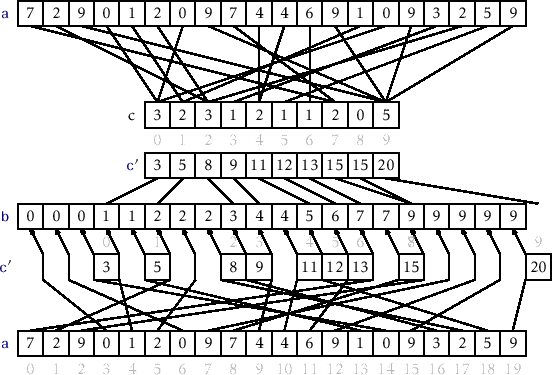
Ask: Is the algorithm faster with or without repeating numbers? If so, which, and why?
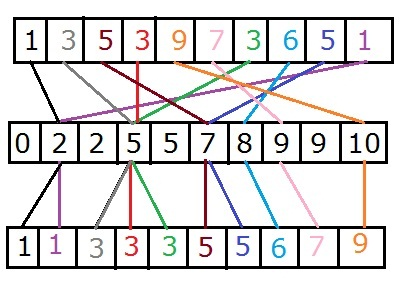
// Conting sort
#include <iostream>
// The main function that sorts the given string arr[] in
// alphabatical order
void countSort(char arr[], int n, int RANGE)
{
// The output character array that will have sorted arr
char output[n];
// Create a count array to store count of inidividul
// characters and initialize count array as 0
// Note: this all-0s syntax only works with {0}
int count[RANGE + 1]{0};
int i;
// Store count of each character
// Ask: How is arr[i] interpreted here?
for(i = 0; arr[i]; ++i)
++count[arr[i]];
// Change count[i] so that count[i] now contains actual
// position of this character in output array
for(i = 1; i <= RANGE; ++i)
count[i] += count[i - 1];
// Build the output character array
for(i = 0; arr[i]; ++i)
{
output[count[arr[i]] - 1] = arr[i];
--count[arr[i]];
}
// Copy the output array to arr, so that arr now
// contains sorted characters
for(i = 0; arr[i]; ++i)
arr[i] = output[i];
}
// Driver program to test above function
int main()
{
const int RANGE = 255;
char arr[] = "hello";
int n = 5;
countSort(arr, n, RANGE);
std::cout << "Sorted character array is " << arr << "\n";
return 0;
}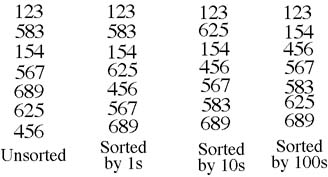
* Radix sort is a non-comparative integer sorting
algorithm that sorts data with integer keys by grouping keys by the
individual digits which share the same significant position and
value.
* Ask: how is it non-comparative?
* A positional notation is required, but because integers can represent
strings of characters (e.g., names or dates) and specially formatted
floating point numbers, radix sort is not limited to integers (discussed
at the end below).
* Ask: why low to high place?
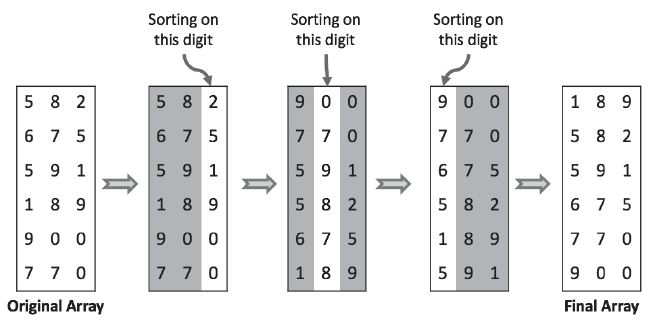
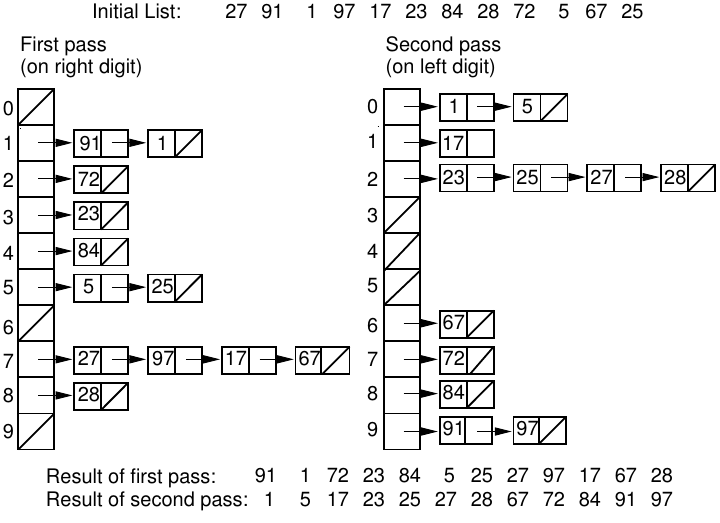
* Using a list of lists
* Note: All numbers do not need to be the exact same
length, imagine leading 0s being sorted for higher places, even if they
are not visualized
We can re-use a good sort for small integers (counting sort).
First, apply counting sort on 1’s, then 10’s, etc.
// Radix sort
#include <iostream>
// r, count array of size r (which is also the base, e.g., 2, 8, 10, 16)
// k, keys/digits (number of digits in the largest number to sort)
// n, size (number of elements in the array to sort)
// This algorithm requires k passes over the list of n numbers in base r
void radixsort(int A[], int k, int r, int n)
{
int B[n];
// This guarantees init to 0 for whole array, right?
int count_arr[r]{0};
int i, j, rtok;
// Loop over place (0s, 10s, 100s, etc.)
// Do a count sort within
for(i = 0, rtok = 1;
i < k;
i++, rtok *= r)
{
// Count the number of records in each bin on this pass
for(j = 0; j < n; j++)
count_arr[(A[j] / rtok) % r]++;
// count[j] will be index in B
// First, reduce count[0] because indexing starts at 0, not 1
count_arr[0] = count_arr[0] - 1;
// Prefix sum on count array
for(j = 1; j < r; j++)
count_arr[j] += count_arr[j - 1];
// Put records into location, working from bottom
// Since fill from bottom, j counts downwards
for(j = n - 1; j >= 0; j--)
{
B[count_arr[(A[j] / rtok) % r]] = A[j];
--count_arr[(A[j] / rtok) % r];
}
for (j = 0; j < n; j++)
A[j] = B[j]; // Copy B back
}
}
int main()
{
int arr[] = {3, 2, 9, 4, 7};
int n = 5;
int r = 10;
int k = 1;
radixsort(arr, k, r, n);
for(int c = 0; c < n; c++)
std::cout << arr[c] << "\n";
return 0;
}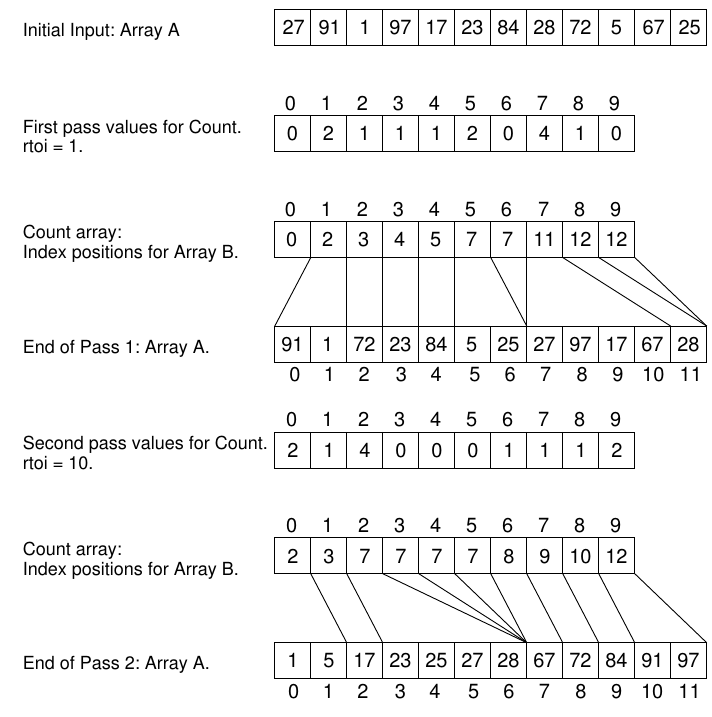
Radix sort is not limited to base 10.
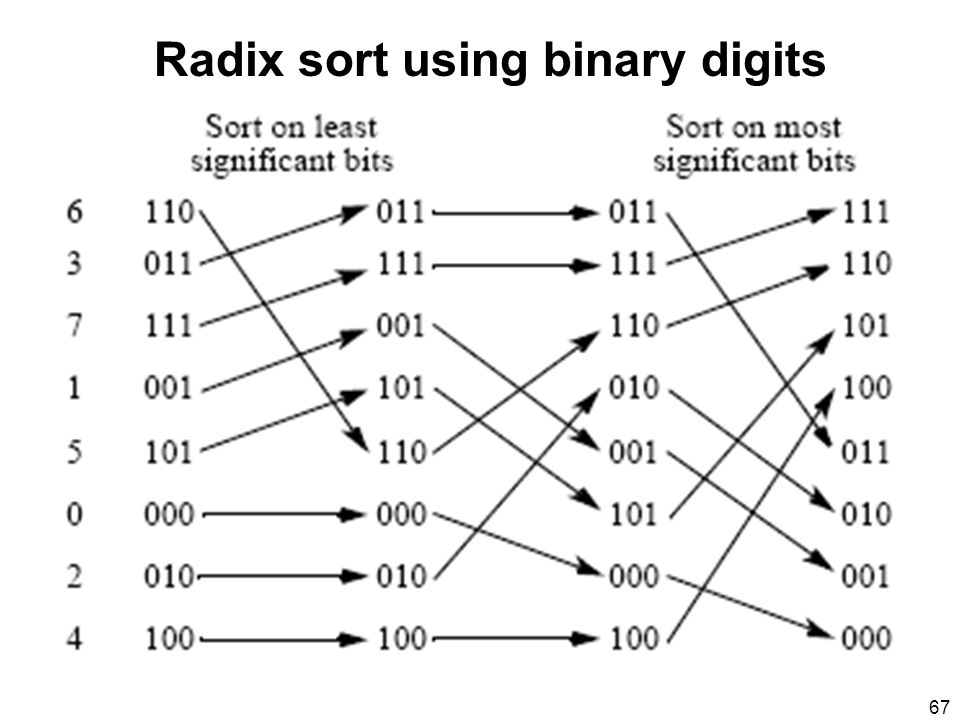
Ask:
* Is it more efficient to sort the same numbers in base 10 or base
2?
* Which loops/steps have more iterations?
* Which loops/steps have fewer iterations?
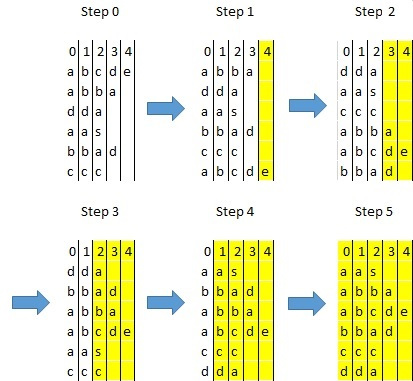
General notes:
* Some of these sorts are not only for integers, for example, when
converting to an integer preserves the original order (ASCII).
* These sorts would not be useful if the encoding scheme did not
preserve order.
* Whether data should be “aligned” left or right depends on the
goal of the sort.
* For example see above, where:
* characters are aligned left (trailing 0s),
* as opposed to the integers, which were aligned right (leading 0s).